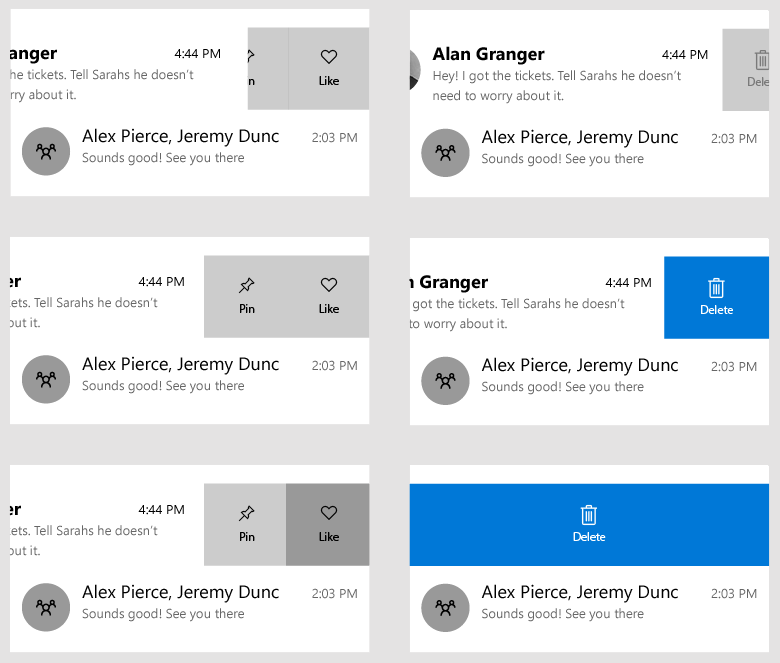SwipeControl Klasse
Definition
Wichtig
Einige Informationen beziehen sich auf Vorabversionen, die vor dem Release ggf. grundlegend überarbeitet werden. Microsoft übernimmt hinsichtlich der hier bereitgestellten Informationen keine Gewährleistungen, seien sie ausdrücklich oder konkludent.
Stellt einen Container dar, der über eine einfache Touchinteraktion den Zugriff auf kontextbezogene Befehle und die Möglichkeit zum Aufrufen von Kontextbefehlen bietet.
Diese Dokumentation gilt für WinUI 2 für UWP (für WinUI in der Windows App SDK siehe Windows App SDK Namespaces).
/// [Microsoft.UI.Xaml.MUXContractProperty(version=5)]
/// [Windows.Foundation.Metadata.MarshalingBehavior(Windows.Foundation.Metadata.MarshalingType.Agile)]
/// [Windows.Foundation.Metadata.Threading(Windows.Foundation.Metadata.ThreadingModel.Both)]
/// [Windows.Foundation.Metadata.Version(1)]
class SwipeControl : ContentControl/// [Windows.Foundation.Metadata.MarshalingBehavior(Windows.Foundation.Metadata.MarshalingType.Agile)]
/// [Windows.Foundation.Metadata.Threading(Windows.Foundation.Metadata.ThreadingModel.Both)]
/// [Windows.Foundation.Metadata.Version(1)]
/// [Microsoft.UI.Xaml.CustomAttributes.MUXContractProperty(version=5)]
/// [Microsoft.UI.Xaml.CustomAttributes.MUXPropertyChangedCallback(enable=true)]
/// [Microsoft.UI.Xaml.CustomAttributes.MUXPropertyChangedCallbackMethodName(value="OnPropertyChanged")]
class SwipeControl : ContentControl/// [Windows.Foundation.Metadata.MarshalingBehavior(Windows.Foundation.Metadata.MarshalingType.Agile)]
/// [Windows.Foundation.Metadata.Threading(Windows.Foundation.Metadata.ThreadingModel.Both)]
/// [Microsoft.UI.Xaml.CustomAttributes.MUXPropertyChangedCallback(enable=true)]
/// [Microsoft.UI.Xaml.CustomAttributes.MUXPropertyChangedCallbackMethodName(value="OnPropertyChanged")]
/// [Windows.Foundation.Metadata.ContractVersion(Microsoft.UI.Xaml.XamlContract, 65536)]
class SwipeControl : ContentControl[Microsoft.UI.Xaml.MUXContractProperty(version=5)]
[Windows.Foundation.Metadata.MarshalingBehavior(Windows.Foundation.Metadata.MarshalingType.Agile)]
[Windows.Foundation.Metadata.Threading(Windows.Foundation.Metadata.ThreadingModel.Both)]
[Windows.Foundation.Metadata.Version(1)]
public class SwipeControl : ContentControl[Windows.Foundation.Metadata.MarshalingBehavior(Windows.Foundation.Metadata.MarshalingType.Agile)]
[Windows.Foundation.Metadata.Threading(Windows.Foundation.Metadata.ThreadingModel.Both)]
[Windows.Foundation.Metadata.Version(1)]
[Microsoft.UI.Xaml.CustomAttributes.MUXContractProperty(version=5)]
[Microsoft.UI.Xaml.CustomAttributes.MUXPropertyChangedCallback(enable=true)]
[Microsoft.UI.Xaml.CustomAttributes.MUXPropertyChangedCallbackMethodName(value="OnPropertyChanged")]
public class SwipeControl : ContentControl[Windows.Foundation.Metadata.MarshalingBehavior(Windows.Foundation.Metadata.MarshalingType.Agile)]
[Windows.Foundation.Metadata.Threading(Windows.Foundation.Metadata.ThreadingModel.Both)]
[Microsoft.UI.Xaml.CustomAttributes.MUXPropertyChangedCallback(enable=true)]
[Microsoft.UI.Xaml.CustomAttributes.MUXPropertyChangedCallbackMethodName(value="OnPropertyChanged")]
[Windows.Foundation.Metadata.ContractVersion(typeof(Microsoft.UI.Xaml.XamlContract), 65536)]
public class SwipeControl : ContentControlPublic Class SwipeControl
Inherits ContentControl<SwipeControl .../>
- Vererbung
-
SwipeControl
- Attribute
-
Microsoft.UI.Xaml.MUXContractPropertyAttribute MarshalingBehaviorAttribute ThreadingAttribute VersionAttribute Microsoft.UI.Xaml.CustomAttributes.MUXContractPropertyAttribute Microsoft.UI.Xaml.CustomAttributes.MUXPropertyChangedCallbackAttribute Microsoft.UI.Xaml.CustomAttributes.MUXPropertyChangedCallbackMethodNameAttribute ContractVersionAttribute
Beispiele
Tipp
Weitere Informationen, Entwurfsanleitungen und Codebeispiele finden Sie unter Wischen.
Die App WinUI 2-Katalog umfasst interaktive Beispiele für die meisten WinUI 2-Steuerelemente, -Features und -Funktionen. Rufen Sie die App aus dem Microsoft Store oder den Quellcode auf GitHub ab.
Hinweise
Die folgende Abbildung zeigt, wie ein kleiner Satz kontextbezogener Befehle über das SwipeControl-Steuerelement verfügbar gemacht werden kann.

Steuerelementstil und -vorlage
Sie können die Standardvorlagen Style und ControlTemplate ändern, um dem Steuerelement ein eindeutiges Aussehen zu verleihen. Informationen zum Ändern des Stils und der Vorlage eines Steuerelements finden Sie unter XAML-Formatvorlagen. Der Standardstil, die Vorlage und die Ressourcen, die das Aussehen des Steuerelements definieren, sind in der generic.xaml Datei enthalten. Zu Entwurfszwecken generic.xaml wird mit dem NuGet-Paket WinUI (Microsoft.UI.Xaml) installiert. Standardmäßig ist der Speicherort \Users\<username>\.nuget\packages\microsoft.ui.xaml\<version>\lib\uap10.0\Microsoft.UI.Xaml\Themes\generic.xaml. Stile und Ressourcen aus verschiedenen WinUI-Versionen können unterschiedliche Werte aufweisen.
XAML enthält auch Ressourcen, mit denen Sie die Farben eines Steuerelements in verschiedenen visuellen Zuständen ändern können, ohne die Steuerelementvorlage zu ändern. Das Ändern dieser Ressourcen wird bevorzugt, um Eigenschaften wie Hintergrund und Vordergrund festzulegen. Weitere Informationen finden Sie im Abschnitt Leichtes Formatieren des Artikels XAML-Stile .
Konstruktoren
| SwipeControl() |
Initialisiert eine neue instance der SwipeControl-Klasse. Diese Dokumentation gilt für WinUI 2 für UWP (für WinUI in der Windows App SDK siehe Windows App SDK Namespaces). |
Eigenschaften
| BottomItems |
Ruft die Elemente ab, die aufgerufen werden können, wenn das Steuerelement von unten nach oben gewischt wird, oder legt diese fest. Diese Dokumentation gilt für WinUI 2 für UWP (für WinUI in der Windows App SDK siehe Windows App SDK Namespaces). |
| BottomItemsProperty |
Gibt die BottomItems-Abhängigkeitseigenschaft an. Diese Dokumentation gilt für WinUI 2 für UWP (für WinUI in der Windows App SDK siehe Windows App SDK Namespaces). |
| LeftItems |
Ruft die Elemente ab, die aufgerufen werden können, wenn das Steuerelement von der linken Seite gewischt wird, oder legt diese fest. Diese Dokumentation gilt für WinUI 2 für UWP (für WinUI in der Windows App SDK siehe Windows App SDK Namespaces). |
| LeftItemsProperty |
Gibt die LeftItems-Abhängigkeitseigenschaft an. Diese Dokumentation gilt für WinUI 2 für UWP (für WinUI in der Windows App SDK siehe Windows App SDK Namespaces). |
| RightItems |
Ruft die Elemente ab, die aufgerufen werden können, wenn das Steuerelement von der rechten Seite gewischt wird, oder legt diese fest. Diese Dokumentation gilt für WinUI 2 für UWP (für WinUI in der Windows App SDK siehe Windows App SDK Namespaces). |
| RightItemsProperty |
Gibt die RightItems-Abhängigkeitseigenschaft an. Diese Dokumentation gilt für WinUI 2 für UWP (für WinUI in der Windows App SDK siehe Windows App SDK Namespaces). |
| TopItems |
Ruft die Elemente ab, die aufgerufen werden können, wenn das Steuerelement von oben nach unten gewischt wird, oder legt diese fest. Diese Dokumentation gilt für WinUI 2 für UWP (für WinUI in der Windows App SDK siehe Windows App SDK Namespaces). |
| TopItemsProperty |
Gibt die TopItems-Abhängigkeitseigenschaft an. Diese Dokumentation gilt für WinUI 2 für UWP (für WinUI in der Windows App SDK siehe Windows App SDK Namespaces). |
Methoden
| Close() |
Schließt das Wischsteuerelement. Diese Dokumentation gilt für WinUI 2 für UWP (für WinUI in der Windows App SDK siehe Windows App SDK Namespaces). |
Gilt für:
Weitere Informationen
Feedback
Bald verfügbar: Im Laufe des Jahres 2024 werden wir GitHub-Issues stufenweise als Feedbackmechanismus für Inhalte abbauen und durch ein neues Feedbacksystem ersetzen. Weitere Informationen finden Sie unter https://aka.ms/ContentUserFeedback.
Feedback senden und anzeigen für